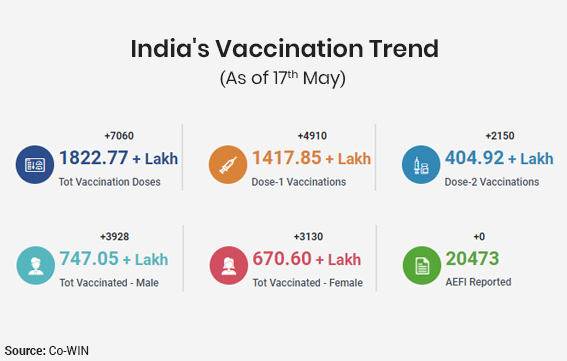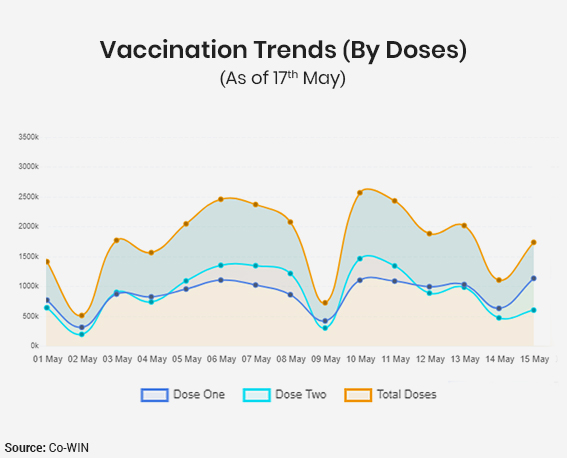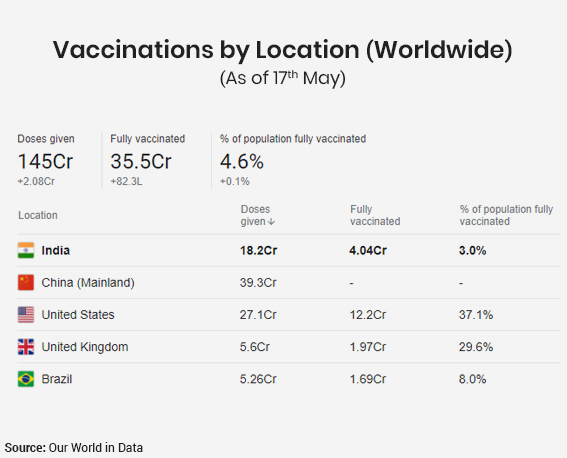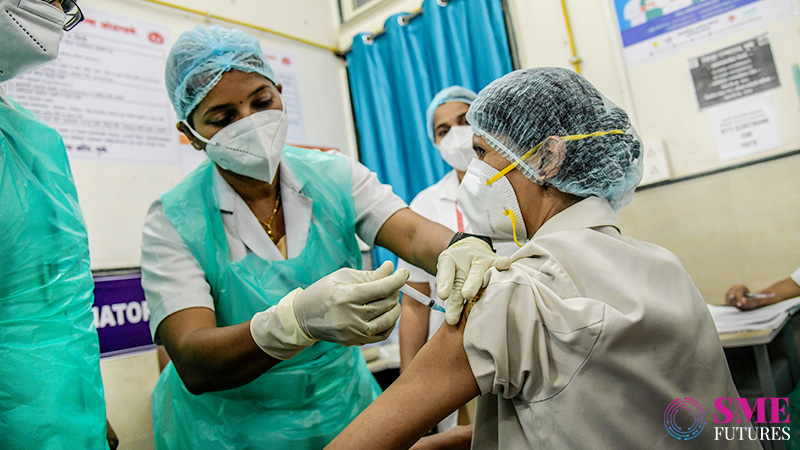The covid crisis is relentlessly bearing down on India, and the situation is steadily worsening.
While the vaccination drive, which is now open for everyone over the age of 18 is turning out to be an epic failure.
Since May 1, it has been a constant struggle to book slots for vaccinations for people from the age group of 18-44. In fact, even trying to book a vaccination slot is usually a futile endeavour.
Due to a dearth of vaccines, there are zero slots available for people who belong to the 18 to 44 age group, for instance in the facilities of Greater Noida, which falls in Gautam Buddha Nagar. In many areas scheduling has not even started.
“I have been checking the government dashboard Cowin, day and night, but there are no slots for the age group of 18-44. I have even checked nearby facilities but only slots for 45+ are shown and they too are full,” says Ena Singh, a 25-year-old digital marketer residing in Greater Noida.
And she is not the only one who has been disappointed by the state of the vaccination drive. People are taking to various platforms such as twitter and commenting on the vaccination shortage and there are many trending hashtags about the same on social media.
The shortage of jabs forces us to question the strategy behind the 3rd phase of inoculation, according to which, PM Modi had promised that the vaccination will be done at a world record pace and that the drive will continue with greater momentum.
But where are the vaccines?
India—which was not too long ago exporting and gifting these jabs, is now facing an acute vaccine shortage, as demand for the jabs has far outpaced their supply.
However, to mitigate the general panic and to clarify further on the matter, the government, on the 3rd of May released a consolidated report on the number of vaccines ordered so far. According to which, in addition to the combined orders from January and March for around 13.5 crore doses of both Covishield and Covaxin, it has also ordered more vaccines on April 28th for the upcoming months of May, June and July.
As per this clarification, 11 crore doses of Covishield with an advance payment of Rs. 1732.50 cr were ordered from SII. While, Bharat Biotech India Ltd (BBIL) has been given an advance of Rs. 787.50 crores for 5 crore Covaxin doses to be made available in May, June and July.
At the same time, the government has also provided nearly 18 crore vaccine doses (17,93,57,860) to States/UTs free of cost, as of the 11thof May.
Even if officially, this is the vaccine data, it is not enough for inoculating a population of 1.3 billion in a few months.
According to a research by Credit Suisse, India needs about 1.7 billion Covid-19 vaccine doses to vaccinate the majority of its adult population, while its target is to administer 40-50 crore doses by July of 2021.
This looks like a near impossible task given the unavailability of the vaccines.
Where are we?

Up until now over 21.5 crore (21,52,54,098) people have registered for vaccination, out of which over 18.2 crore (18,22,77,115) have been inoculated, as of the 17th of May. Out of this figure, only 4,04,92,438 i.e., over 4 crore are completely inoculated. Which means that a mere 3 per cent of the Indian population has been vaccinated.

But this pace is way too slow considering the fact that India wants to induce herd immunity in its population at the earliest.
In the last one month, things have changed dramatically in terms of the daily numbers, as claimed by Michigan University epidemiologist Bhramar Mukerjee on twitter. COVID cases have risen 3.6 times, deaths have gone up 6.3 times, but the tests have only gone up 1.5 times the previous numbers. More importantly, daily vaccine doses have fallen by 38 per cent.
Inoculation in May is way lower than needed as compared to the peak India achieved on April the 5th. That day, 43,00,966 people got the jabs. Considering that this is a downward spiral, it makes the country more vulnerable to the third wave.
Eventually, it is not too hard to realise that if India needs to engender herd immunity, the government needs to drastically scale up the vaccination drive. As per the analysis of a SBI Ecowrap report, with an average rate of 17 lakh per day in May, India will only be able to vaccinate 15 per cent of its population by October of 2021.

Noting the slow pace of the inoculation process, experts from Fitch Ratings, in a statement, have alerted that India’s slow pace of vaccination means that the country could remain vulnerable to further waves of the pandemic even after the current surge subsides.
At the same time, The Lancet medical journal in its editorial on the 8th of May called out India’s vaccination drive as a ‘botched vaccination campaign’. It asked India to pursue a two-pronged strategy to overcome the disastrous second wave—first, the botched vaccination campaign must be rationalised and implemented with all due speed and second, India must reduce SARS-CoV-2 transmission as much as possible while the vaccine is being rolled out.
The journal further underlined two immediate bottlenecks that are hampering vaccination—inadequate vaccine supply and distribution in urban and rural areas.
“The government must work with local and primary health-care centres that know their communities and create an equitable distribution system for the vaccine,” it suggests.
Ramp up production
Many people are of the opinion that the vaccination drive has failed due to manufacturing reasons.
“When we compare our vaccination drive vis-à-vis other countries, it has been one of the well-executed ones. However, the vaccination drive is still ramping up given our size of the population – we need to have enough manufacturing capacity to serve the demand,”
says Sumit Goel, Managing Partner and Head – Healthcare, Pharma & Life Sciences, Praxis Global Alliance.
He continues, “Given the size of our population, supply capacity should have been well planned and the government should have explored ways of supporting the manufacturers much earlier since the capacity build-up takes time.”
At the beginning of 2021 and the inception of the first phase of the vaccination drive, India prematurely thought that it could turn the tide of the pandemic. But everything came crashing down once the second wave hit us with unseen and unexpected ferocity. But whatever the situation is, to control the extent of the second wave of COVID-19, the adequate availability and rapid administration of the COVID-19 vaccine is very crucial.
This can only be attained by fast forwarding the production of the vaccines. However, this may take a while and the country must face a vaccine shortage for a few more months.
Dr Virander Singh Chauhan, a renowned Indian scientist, in a column in Indian Express, explains the why factor, “Vaccines are complex formulations of many components and depend on a seamless supply of raw materials that are mostly imported. From production of the bulk material to filling of the formulation in vials, it is a highly complex and time-consuming process that cannot be hastened. Ramping up of existing production, even after adequate funds are available, will inevitably take a minimum of 2-3 months,” he avers.
SII and Bharat Biotech which currently have a duopoly in vaccine manufacturing are positing that the same amount of time is needed to ramp up the manufacturing process.
As per various sources and public reports, SII’s vaccine manufacturing capacity is around 7 crore doses per month. It is supposed to enhance its manufacturing capacity to 10 crore doses per month by July with the help of a government investment of Rs 3000 crore. While Bharat Biotech has a much lower manufacturing capacity of 0.6 to 1.5 crore doses per month, with three manufacturing facilities in Hyderabad and Bengaluru. The firm is now expecting to ramp up production to 6 crore doses by August 2021.
But if we look at the current rate of manufacturing, the combined production by both these vaccine makers is less than what was originally estimated, i.e., around 7 to 8.5 crore doses every month, as they are not earning enough to plough money back into capacity enhancement, due to the prices. Initially, Covishield was procured for Rs 210, but its price is now down to Rs 150 excluding taxes. For private entities, the price for the consumer has been capped at Rs 250 per dose, leaving approximately Rs 100 for the hospital.
In addition to that, the vaccine numbers which we are discussing here (7 to 8.5 crore doses) go down further, if we add factors such as exports. As per the various analyses, taking into account the export commitment which is up to 15 per cent of the total production, the vaccine supply constricts to 6 to 7 crore doses per month, which is not enough given the current scenario.
Meanwhile, the Drugs Controller General of India granting approval to Russia’s coronavirus vaccine Sputnik-V for restricted use gives us some hope that the vaccine shortage can be remedied. Dr. Reddy’s Laboratories Ltd received 1.5 lakh doses of Sputnik V on May 1, which has been given a clearance chit on 13th May after a strenous clearance process. Currently, each imported dose cost Rs 995.4 including 5 per cent GST tax. Once domestic production starts, price will eventually come down.
Russian Ambassador to India, Nikolay Kudashev to ANI said, “(The) Sputnik V is Russian-Indian vaccine. We expect that its production in India will be gradually increased up to 85 crore doses per year. There are plans to introduce single-dose vaccine soon in India-Sputnik-Lite.”
Whereas, a second consignment of 60,000 doses reached on 16th May, of which samples are to be tested at Central Test Laboratory.
The route that the government should take
A lot of brainstorming has been going on about what went wrong, what went right, what should be the next step and strategy for further vaccinations and what are the key takeaways from the current state of the vaccination drive.
Goel of Praxis strongly feels that India has learnt a few lessons from what we are experiencing today. “In my opinion, extraordinary situations require a different way of thinking,” he says. According to him, the government should have foreseen the situation and should have readied an action plan beforehand. “In the US and the EU, governments gave advance purchase orders and payments to pharmaceutical companies to develop the vaccine, knowing very well the risks involved. The government should have worked out ways to maintain a supply of vaccines in its discussions with vaccine manufacturers,” he adds.
He further continues, “In addition to that, the government should have employed a more practical way for the allocation of the vaccines. For instance, more quantities should have been earmarked for areas with a higher incidence of COVID infections.”
An editorial analysis by Tejal Kanitkar, Associate Professor at the National Institute of Advanced Studies, Bengaluru, suggests that for universal coverage by the end of the year, India requires around 22 crore doses per month.
Which is why India Inc. suggests that the government should directly incentivise the foreign companies which own the patents for the other Covid-19 vaccines, to grant licences and transfer their technology to the domestic pharmaceutical companies in India.
To put it in simple words, voluntary licensing refers to the authorisation given by the patent holder to a third party to manufacture and sell the patented product on the basis of mutually agreed terms.
Suggesting that as a solution, Sanjay Aggarwal, President, PHD Chamber of Commerce and Industry says, “At this juncture, the government should facilitate and encourage Bharat Biotech, Oxford-Astra Zeneca and RDIF to grant voluntary licenses along with transfer of technology, even if for a limited period of one year, for the production of Covaxin, Covishield and Sputnik to more and more pharmaceutical companies in India on mutually accepted terms so as to maximise the production and supply of vaccines in the country.”
In fact, there is also a need to provide assurance of procurement to both the existing manufacturers and the proposed new licensees, of the vaccine doses produced by them, to encourage them to expand their facilities and ramp up their manufacturing process, according to Aggarwal.
But it is not as easy as it seems
Even if companies issue voluntary licences to third parties, the process will be long, and it will take an ample amount of time to produce the desired results. Manufacturers will need government support to identify manufacturing candidates in developing countries, create the legal structure, supply the necessary manufacturing equipment and expertise, and so on, as mentioned in the Harvard Business Review.
As per the analysis, there might be additional obstacles which can hamper the production strategy. “Additional obstacles in many developing countries include the need to install new manufacturing equipment or upgrading existing equipment, a shortage of skilled and experienced chemistry, manufacturing controls and quality management professionals, the lack of a strong national regulatory agency to evaluate and approve the manufacturing process, and difficulties in obtaining from abroad adequate supplies of vaccine ingredients and equipment, especially single-use equipment such as bioreactor bags and filters,” it reads.
That means that the small pharma players are out of the picture as third-party production candidates. The making of the COVID vaccine requires giant contract manufacturers with expertise to scale up production.
In simple words, it does not matter if a small manufacturer can make 5000 vaccines, it will simply not count.
Goel adds in his thoughts, “There are two issues that will arise if small pharma contractors want to get into vaccine production. Firstly, vaccine manufacturing requires a highly specialized production process and secondly, creating such capacities would take time and they may not be able to do a better job than the already existing vaccine manufacturers,” he says.
Raw material constraints can hamper vaccination
Another challenge that India is facing is maintaining the flow of raw material.
China, the UK, and the US provide most of the raw material for vaccines. Companies such as Thermo Fisher Scientific Inc, Pall Corporation and Cytiva provide essential raw material such as filters, tubing and specialized disposable bags.
But the USA has invoked the war time Defence Production Act (DPA), which has thrown vaccines makers outside the USA in jeopardy. Actually, DPA forces American companies to prioritise domestic consumption and demand.
Given this scenario, US based companies are left with no option but to give priority to the production of COVID-19 vaccines and Personal Protective Equipment (PPEs) for domestic usage to combat the deadly pandemic in America, the worst-hit nation.
However, after the DPA drew much criticism globally and after weeks of appeals from the Indian government and SII, which is currently India’s largest producer of the COVID-19 vaccine; last month, the US govt announced that it will lift the export ban on essential raw components, however, it has still not set the terms for that.
Experts see this as an adversity for India.
In a recent interview with the New York Times, Serum Institute chief Adar Poonawalla, speaking about the US lifting the ban on the supply of raw material, said that he was given the confidence that the supply of raw materials would begin soon, but till now it had not been received.
Without the raw material, it is going to be difficult to ramp up the production of vaccines and India needs to up the pace of its vaccination drive to curb the second wave.
The scenario is anything but predictable
No expert can predict the definitive supply and demand scenario. And the fact that billions of doses are needed to combat this pandemic only adds to the already daunting challenges being faced by our country today.
The bottlenecks can vary with the scaling up of production, addition of new vaccines, demand volatility, and new data on the differential efficacy of vaccines against new viral variants. This means that the manufacturers of different types of vaccines will have to deal with a high degree of uncertainty on the assembly lines in a few months from now.
Goel comments on this, “The unspoken factor in not creating huge capacities has been about what would the manufacturers do with the huge capacities once the COVID wave has subsided. Some part of the extra capacity could be re-purposed, but the balance would sit idle on the balance sheets of the companies – a scenario no private company would want unless it’s paid for. Not addressing this fundamental concern has led to the current supply situation.”
Currently, the demand for vaccines is way higher than their supply is. Nonetheless, companies are forming partnerships to expand their vaccine manufacturing capacities and keep the supply chain functioning smoothly. We can only hope that this helps to bridge the demand and supply gap for the vaccines because India’s tika utsav can’t succeed if times remain this uncertain and unpredictable.











